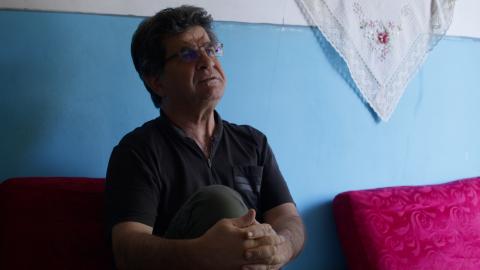NO BEARS: A Reflective Tale About Images and Truth

Jafar Panahi in NO BEARS
This review of Jafar Panahi's No Bears was written by David Vanden Bossche, PhD candidate in the Department of Communication Arts at UW-Madison. No Bears will have its Madison theatrical premiere on Thursday, February 9, at 7 p.m., in our regular Cinematheque venue, 4070 Vilas Hall, 821 University Avenue. Admission is free!
By David Vanden Bossche
After a 'New Wave' of Iranian Cinema in the late 1960s and early 1970s, Jafar Panahi was part of the second ‘New Wave’ that gained prominence in the 1990s after the international success of films by the late Abbas Kiarostami (Close-Up, A Taste of Cherry). After winning several prizes in the film festival circuit for films like The White Balloon and The Mirror, Panahi’s career took a much darker turn in 2010 when the Iranian authorities convicted him of national security violations stemming from a documentary he was making chronicling the protests that followed the disputed reelection of Iran's then-president, Mahmoud Ahmadinejad. Even after being placed under house arrest, the director managed to keep working, sometimes smuggling his films out of the country to ensure overseas screenings at several renowned festivals. Since Panahi has not been allowed to leave Iran for more than a decade, No Bears was also filmed under circumstances that restricted the director’s freedom, but this time these restrictions became an integral part of the film’s concept. (Just prior to the No Bears premiere at the Venice Film Festival, where it won a special jury prize, Panahi was arrested in July 2022 in Tehran and ordered to serve a six-year prison sentence for "propaganda against the system" that had been suspended after he served two months in 2010. Two days after beginning a hunger strike last week, Panahi was released from prison.)
As in the movies directed by his mentor Abbas Kiarostami, the director himself often plays an important role and this alter ego often functions as a conscious presence within the fabric and stories of Panahi’s films. In No Bears, a conversation is created between the director’s own story and the narrative we watch unfolding onscreen. Panahi plays a thinly veiled version of himself: a director who oversees the shoot of a film from his laptop while he is spending time at a remote village near the Iranian-Turkish border. Panahi is shown wrestling with uncooperative technology and inquisitive villagers, while trying to work through the footage his assistant is sending him from Tehran. The film-within-the-film revolves around a couple trying to leave Iran with false documents, while the actors playing the couple are themselves wrapped up in a similar situation. Panahi's own situation of not being able to leave the country becomes another element in the tapestry of threads being woven together, as does a clandestine romance in the village that may or may not have been accidentally captured by Panahi’s camera. Bringing all of these premises together, the film creates an intricate network of meanings and metaphors that becomes more complex and interesting as the narrative unfolds.
In visualizing these ideas, Panahi, like Kiarostami, rarely changes camera positions. Panahi also provides a clear nod to the scene in Kiarostami’s The Wind Will Carry Us when the protagonist is searching for the highest point in the village to try and get some reception on his cell-phone, but Panahi’s most daring interaction with the oeuvre of his mentor is the way in which – echoing Kiarostami’s Close-Up – the film constantly questions the relation between film and reality. The viewer witnesses the manipulation necessary to create images and meaning, and because we side with the protagonist/director, we also become accomplices in providing meaning to these images. The building blocks of cinema– color, movement, editing, sound – are foregrounded here in a reflective tale about images and truth. At the end of the film, it becomes clear that the references to The Wind Will Carry Us are not just playful or coincidental. Kiarostami's central theme, to paraphrase Professor Tom Paulus of Antwerp University, is that the lie of cinema uncovers the truth, and Panahi reworks that theme for a new, digital age. For Kiarostami, the poetic beauty and power of the ‘cinematic lie’ (the ‘illusion of art’ if you like) was necessary to uncover fundamental truths about life. For Panahi, then, this lie can no longer just lead to the utopian (platonic?) idea of truth and life that his predecessor believed in, there’s now a rude awakening and a call for the caution and responsibility that need to be the filmmaker’s – or rather ‘image maker’s’ – part when creating images and releasing them into the world.
It is this fascinating dialogue with the cinematic traditions that shaped him and guided him throughout his career, that make Jafar Panahi’s No Bears his most accomplished and richest film since his breakthrough over a quarter of a century ago with The White Balloon.
